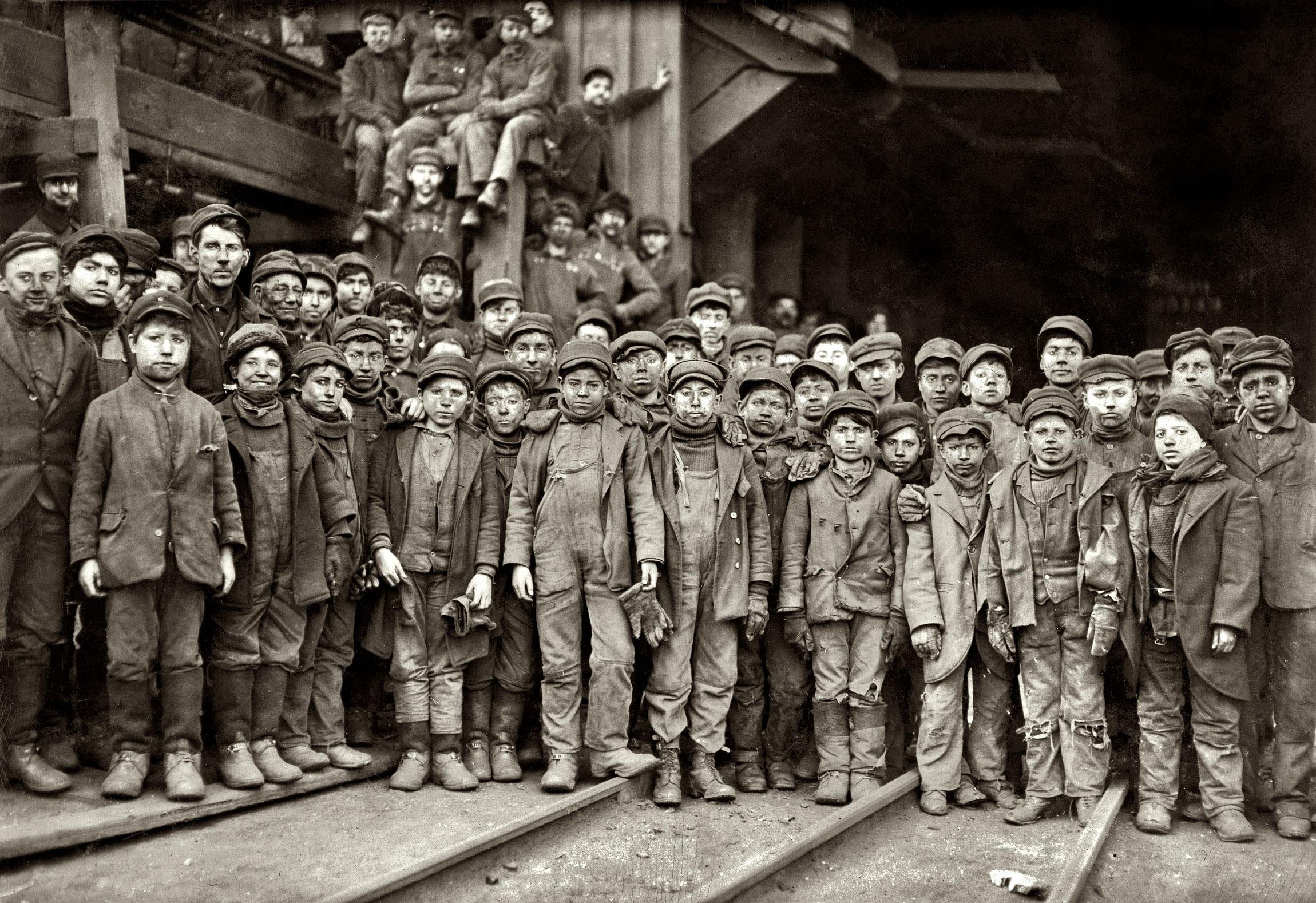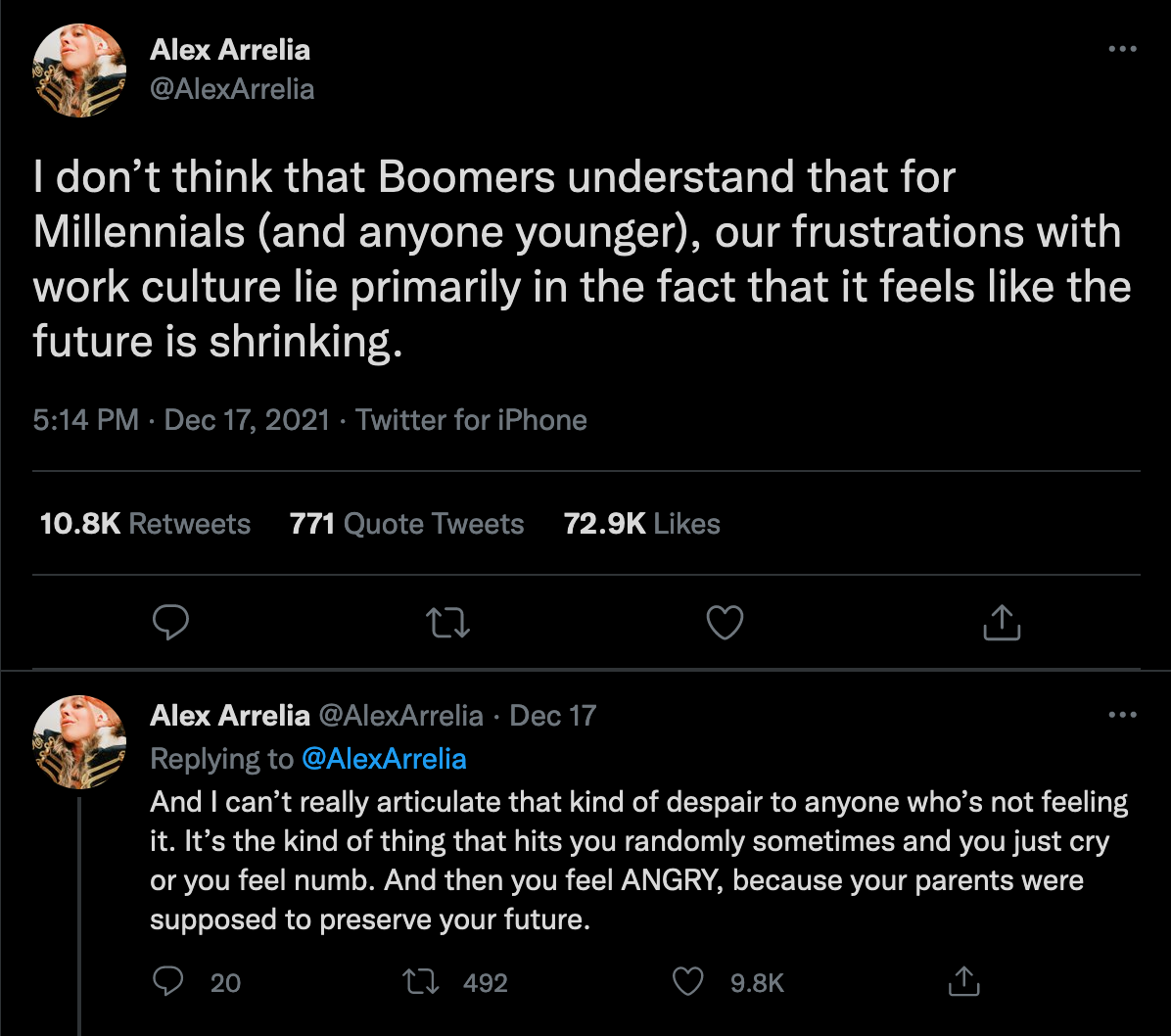The Kids are not Alright
Humanity is at an inflection point. Younger people cannot earn as well as previous generations, they are saddled with debt and rising health costs, many of the social protections that we once held sacrosanct are eroding, and climate change appears to be in full-throttle and threatening our survival; the prospect of a secure future is vanishing.
The way we were
Since the dawn of civilization, society has built itself largely around youth. This was due, in part, to the fact that children were a key component of the social and economic fortunes of a family, a community, and a nation. Many young people entered employment at an early age and became net economic producers before they were fully formed adults. Nearly a century ago, my own grandfather began working in the coal mines of Western Pennsylvania at the age of 14, and this was normal for people in his socio-economic class.
Source: Library of Congress
For most of our history, a large number of children died, and data suggests that a quarter of them passed away before their first birthday and nearly one-half by adulthood. Incredible efforts were undertaken to fix this problem through social and scientific innovation over the years, and today more than nine in ten children globally survive till at least the age of 15. It's a remarkable feat, and one that we should all applaud; it may be the single greatest achievement of our species.
Demographic shifts change the world
This shift in youth mortality invariably altered the life-course, as well as our demographic future and resource allocations. It improved the likelihood that an individual would reach “old age;” today nearly three-quarters of all people in the U.S. will live till at least 65. However, it also caused the global population to quadruple in size from roughly two billion people when my grandfather was born in 1914 to nearly eight billion people today.
Source: Our World in Data
This incredible explosion of people of all ages put unimaginable strains on our social and economic norms, as well as physical and natural environments. Cohesion is frayed and the lack of unity threatens democratic capitalism, as well as the institutions that provide social and economic protections to millions of people.
The kids know this, they are mad, and they aren’t going to take it anymore. They are not alright.
A recipe for disaster hidden in triumph
There is no single intervention that can be credited with keeping children alive into adulthood, or extending life expectancy for all of society. Rather, it was a series of incremental steps, as well as the occasional leap forward, that got us to this point. Public investments in compulsory elementary education, labor laws, clean water and sanitation, vaccines, as well as food safety all get credit. We roughly doubled average life expectancy in 100 years.
Source: Our World in Data
At the same time society was working to improve the survival rate of kids, it was also shoring-up the prospects for health and economic security of older populations. It did so through the creation of public pension and health care systems. The stability of these social welfare programs was largely predicated on constant economic growth, consistent life expectancy, as well as relatively small older populations. Its success was all but guaranteed, at least until the demographic realities began to shift.
The confluence of these improvements at the beginning of life, when coupled with a strong post-war economy, created the ideal conditions for the baby boom; periods of prosperity are strongly correlated to birth rates. However, it wasn’t just the sheer number of children that were born. Rather, it was that most of these kids were able to survive well into adulthood and old age. For reference more than nine in ten boomers who were born are still alive today.
Capitalism, which demands efficiencies to maximize profits, prompted the expansion of factory farming, over reliance on global supply chains for cheap goods, and the use of fossil fuels for transportation and plastics. We achieved incredible potential, but this all came at a cost, and one that haunts us today. Society chose expediency over sustainability, and rewarded leaders - both public and private - who cut taxes and chose profits over people.
“Young people have been left with a mess. Economic inequality was no longer the exception; it became the rule.”
As a result, boomers were able to gobble up an incredible amount of wealth and, while this was not distributed equally amongst them, it was an achievement. Regardless, it was done so at the expense of equity and the success of future generations. Young people have been left with a mess. Economic inequality was no longer the exception; it was the rule.
Source: The Economist
Today, the middle class is shrinking thanks to increasing costs of living for everything from education to healthcare. Incomes have simply not kept up, which imperils a secure future for all generations. Even buying a home, which used to be de rigueur, is out of reach for many, since the cost of housing has risen faster than wages for decades.
A thorn in the side of the future
There’s no question that boomers control the vast majority of wealth in the United States and around the world. Organizations like AARP and experts like Joe Coughlin have made it clear that the spending power of this generation rivals that of entire economies. They often retort that the “longevity economy,” or the economic activity of all people over 50 in the U.S., equates to being the third largest economy in the world, just after the U.S. and China.
“Despite their apparent wealth, an odd sort of protectionist generational gerontocracy has emerged where... protecting wealth and maintaining it at all costs is the name of the game.”
There’s also a demographic reality that there are a lot of boomers - more of them than any other generation with the exception of millennials. Older populations tend to be more politically active than their younger cohorts, and are concentrated in rural states too, where they hold more political power per capita in a representative democracy like the U.S. This makes them a force to be reckoned with, and those that represent them are aware of their power.
Source: Twitter
Despite their apparent wealth, an odd sort of protectionist generational gerontocracy has emerged where the boomer mantra appears to be to lower taxes while keeping Social Security and Medicare solvent, all while removing environmental regulations and defunding education. Protecting wealth and maintaining it at all costs is the name of the game. This has to change.
Meeting the challenges of the Super Age
In order to address the realities of the coming Super Age, as well as secure the financial futures of the youngest generations, liberal societies need to act fast. Generation X, loosely defined as born between 1965 and 1980, Millennials between 1980 and 1995, and Generation Z between 1996 and early to mid-2000s, all exhibit a general lack of confidence in the future viability of Social Security and, according to the 2019 Transamerica Retirement Survey; approximately 4 out of 5 are concerned that Social Security will not be a viable program when they retire.
Younger generations have higher savings rates than their older peers, which is good news, but they cannot save enough due to crippling debt and rising costs of living. Younger people are also more likely to be employed in gig and part-time work, which doesn’t contribute to private and public savings vehicles at the same rate as a full-time job. This means that while these younger generations are saving at higher rates, they are saving on average less per person, which threatens their longer-term savings and financial goals .
The good news is that unlike older generations, millennials and Generation Z generally share more positive attitudes towards the role of government; both groups believe that the state should have a larger role in ensuring financial security later in life.
Research has also found that nearly a quarter of millennials and Generation Z believe that it is critical to preserve Social Security for future generations, even if that means increasing taxes on working Americans. This can only be done if the current social contract is revised to be more equitable to all generations, and this can only be achieved through a broad and generationally diverse coalition.
Younger entrepreneurs, perhaps in part because of their predicament, or more likely because of their deep understanding of the realities that face society in the Super Age, are turning their energies to building market-based solutions that can relieve some of the pressures created by demographic change. Aidaly, Carevocacy, GetSetUp, PAPA, and UpsideHôm are just a handful of millennial and Generation Z-owned companies that are working to close the gap in earnings, digital literacy, support services, and housing.
There are also a slew of social and economic justice warriors who are taking the fight to the streets by shining a light on the generational income gap. They are pulling together a diverse coalition of interests and ages that have already aligned themselves around other major issues of our time, like racial and gender equity, as well as climate change. There is hope.
The Beatles may have been the ones that sang, “They say you want a revolution,” but they also raised the question, “Will you still need me, will you still feed me when I'm sixty-four?” It turns out that millennials and Generation Z are the ones that will foment a revolt in the end, all while delivering market-based solutions for the Super Age where policymakers have failed.
Going backwards was never an option.







